History of the development of playing cards
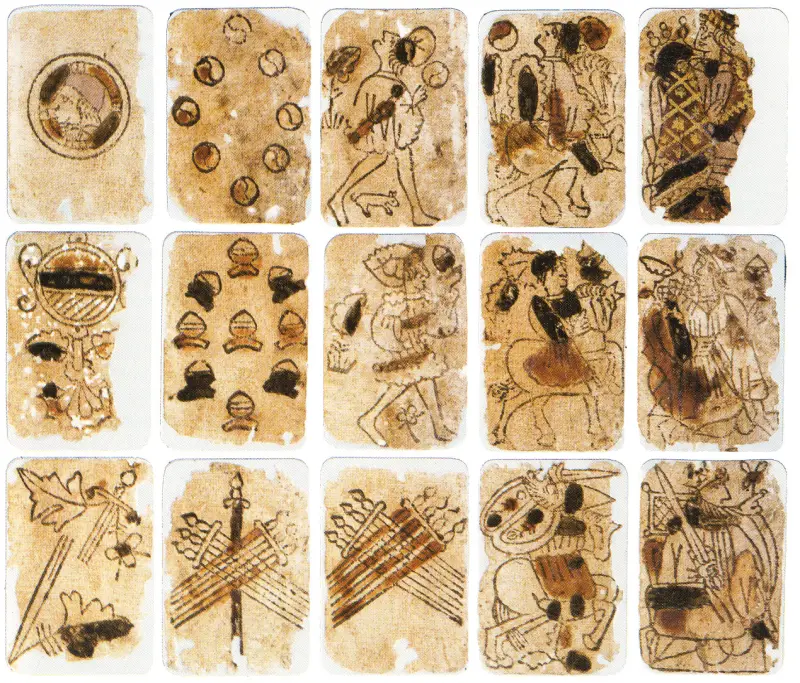
Italian maps of the early 15th century.
Initially, decks were drawn by hand, covered with gold, and a high-quality handwritten deck was valued at a high level. But over time, production becomes simpler and the cards change. And before us is such a familiar deck. But what a path she has traveled over many centuries!
Where did playing cards come from?
Even scientists cannot determine exactly where playing cards appeared. Their theories are based more on speculation than on facts. We know about the approximate date of the appearance of cards and card games from a manuscript of 1377 by a certain Swiss monk Johannes. There is a widespread belief that maps were brought from the East. Perhaps they were gypsies, crusaders or traders.
Also, playing cards could have been brought by the Arabs from North Africa, first to Italy or Spain, and from there they had already spread throughout the continent. It is believed that maps were invented in Ancient China, around the 9th century, during the reign of the Tang Dynasty. And from there they spread to Persia, Egypt, and then came to the Europeans.
How did cards influence society?
Some scientists suggest that initially the cards did not fulfill their main function. At its dawn stories they were play money, with their help players made bets in other games. But, be that as it may, playing cards influenced people more than other games.
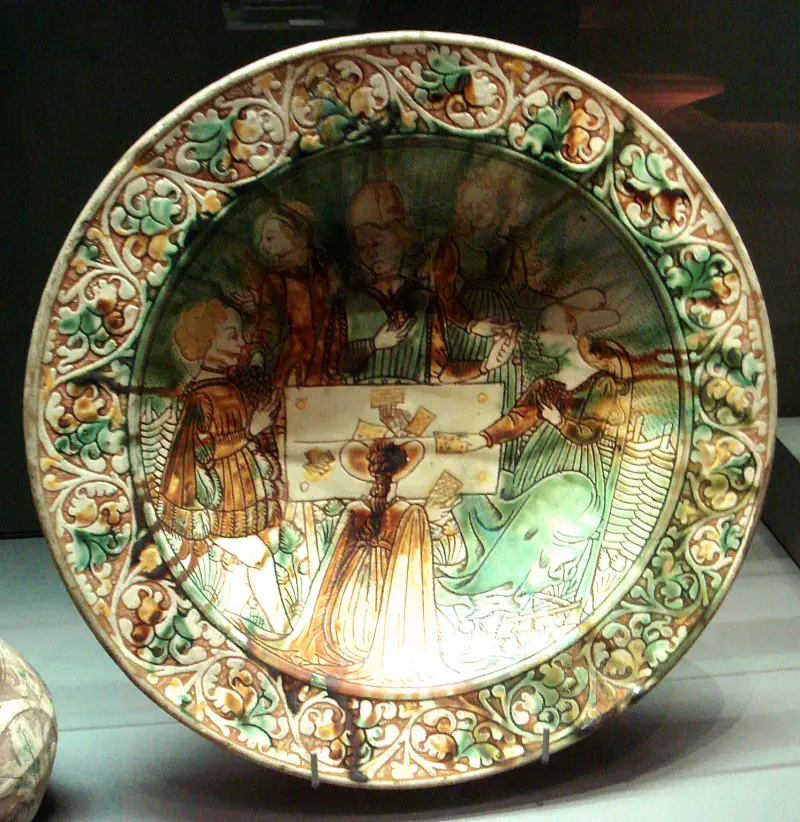
15th century Italian plate depicting card players
Maps, which appeared during the Gothic period, became a conductor of taste and culture. Initially there was no single design, and the cards were different from each other. The creators were inspired by folk fables, novels, and funny scenes from life. Maps then reflected society, as they did later in the bright Victorian era, which saw their greatest heyday.
In the 14th and 15th centuries, fundamental economic and religious changes took place in Europe. The population began to actively move from villages to cities. A new form of economy was developing, where artisans and traders took the leading roles. Art, science, and trade relations developed. People began to spend more time having fun after work and getting together. And cards were great for this. Luxurious decks were made for the rich, simpler decks for ordinary city dwellers. Everyone who was not too lazy began to make maps - jewelers, wood and copper engravers, carvers, sculptors, artists, bronzers, etc. Thanks to Gutenberg and his machine, maps could be printed faster and in large quantities, which contributed to their spread throughout Europe and growing popularity. Over time, they became part of a subculture and reached Japan and Latin America.
But the attitude towards cards at the dawn of their popularity was ambiguous. The first chronicles mention that the secular and religious authorities did not approve of the players and cards. In 1423, Saint Bernadine of Siena preached against cards, calling on sinners to repent and burn the decks. But over time, the cards became more integrated into society. Already in the XNUMXth century, jokes, sayings, and expressions that relate to cards steadily entered the everyday lexicon. For example, players were called sharpers, cheats and swindlers, playing cards were called the devil's picture book. The cards acquired social, love, and fortune-telling meaning; they united different categories of people.
Cards had a negative impact on gambling people. They easily became victims of sharpers, swindlers who understood that they could get rich from cards and the passion of their victims. For example, the famous English lawyer and humanist Thomas More believed that taverns and pubs where they play dice, cards, and table tennis are dens of thieves. In his novel “Utopia,” he mentioned that he liked chess, music and pleasant conversation more.
How many people have started losing fortunes! Although gambling existed before this, cards became the apogee of excitement. Of course, after the loss, many players behaved inappropriately and began to get rowdy. But this was considered immoral behavior then, and such a person was quickly taken out, for example, from the tavern where he had lost.
Playing cards were typically used for casual and skill games. In the first case, luck influenced the result, in the second the majority depended on the sleight of hand of the gambler. If previously chess, checkers, and dice games were popular, now cards are popular. Over time, they even began to predict destinies with their help, for example, Tarot cards appeared.
What were playing cards like in European countries?
Initially, in European countries, cards differed not only in suits, but also in characters. Each country used its own drawings that reflected its reality. For example, somewhere kings sat on horses, somewhere on thrones. This was influenced by cultural and artistic traditions, different hierarchies, liberal or conservative tendencies, language, fashion, etc. Let’s take a closer look at how playing cards differed in the countries of Medieval Europe.
Italy and Spain
In Italy and Spain, before the advent of classical suits, cups, coins, swords and polo sticks were used. These so-called Latin suits can still be found today on some versions of decks.
Court cards in Italy at that time consisted of a king on a horse, a seated and crowned queen, and a jack. The latter played the role of a servant at court, and in some versions he was a prince. But later it was called “jack” so as not to be confused with the king. Spanish cards only had king, knight and jack. There weren't even ten ladies.

Card kings in different countries and in different years
Germany
Cards came to Germany from Italy with the help of traders and soldiers. To identify their cards, the Germans swapped the Italian suits for their own - acorns, leaves, hearts and hawk bells. Falconry was a common activity in the German countryside in the 48th and XNUMXth centuries. There was also no lady. Only a king and two jacks - top and bottom. There was no ace, and the main card was a deuce. Therefore, there were XNUMX cards in the deck.
Each master in Germany tried to make his own deck design, so the symbols of the suits were different. There were animals, kitchen utensils, ink, etc. In neighboring Switzerland, flowers and shields were used instead of leaves and hearts, respectively.
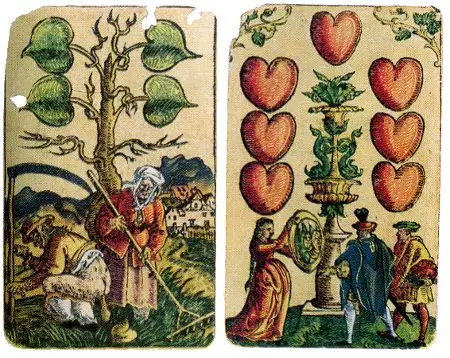
German maps by Peter Flettner of the vulgar daily activities of ordinary people, satirizing bourgeois pretentiousness, Nuremberg, c. 1535-1540
But the main merit of Germany is that it began to print game cards more than anyone else. Of course, this was facilitated by the invention of the printing press. It got to the point that German cards with their national suits began to be sold to Spain and Italy - to the countries where these cards came from.
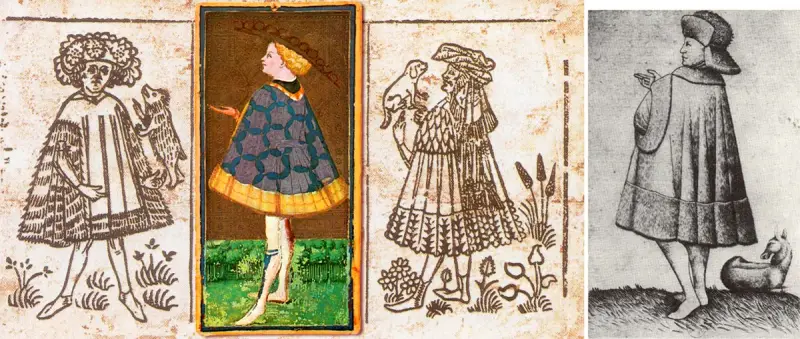
Correspondence between early Italian and German maps
France
We owe France the classic suits. Hearts, diamonds, clubs and spades appeared around the beginning of the 15th century. It is likely that clubs came from acorns, spades from leaves. Also, the French king, queen and jack have become classic high cards. But that’s not all that the French came up with. They divided the suits into two colors - red and black. This took root in Europe, and in the second half of the 15th century, French maps outstripped German ones in popularity. It turns out that the cards we are familiar with owe their appearance to French masters.
Also in France, high cards began to be given names. The king of spades is King David, the king of clubs is Alexander the Great, the king of hearts is Charlemagne, the king of diamonds is Julius Caesar. The queens of spades, hearts, diamonds and clubs were associated with Pallas Athena, Judith, Jacob's wife Rachel, and Argina, respectively. The jacks of spades, hearts, diamonds and clubs were Charlemagne's knight, La Guira, Hector and Lancelot respectively. And the suits represented the four empires - Jewish, Greek, Frankish and Roman.
Clothing, weapon, the poses and accessories of the heroes of the French cards were different. But at the beginning of the 18th century, a tax was introduced on playing cards in France, the country was divided into nine regions, each of which had its own unique design.
England
Presumably, cards were brought to England not from France, but from Belgium thanks to the soldiers. Although before this there were Spanish and Italian maps in the British Isles, they were not popular. In France, large taxes were introduced on the production of cards; craftsmen moved to neighboring Belgium, where they opened factories. And from there, first by soldiers and then by merchants, cards began to be actively transported across the strait.
Of all the cards, the Ace of Spades has a special place. This is what we see on decks, in gaming clubs, films, and the design of poker rooms. He owes this popularity to the British. They passed a law that first the manufacturer pays tax on the cards, and only then puts them up for sale. Therefore, tax officials made a special imprint on the cards. And since the Ace of Spades was often the top card, it was embossed on it. But, of course, they tried to avoid taxes. Therefore, in 1828, Great Britain decided that the Ace of Spades had to be purchased from the Stamp Duty Commissioners. The amount of duty and the name of the manufacturer were indicated on the card. Only 30 years later, manufacturers were allowed to print this map in their workshops. By the way, the familiar images of kings, queens and jacks appeared around the same years thanks to the master Charles Goodall.
How were cards originally made?
Before the invention of the printing press, craftsmen made maps by hand. This is a long process, so the cards were expensive. But after the machine appeared, cards began to be printed quickly and in large quantities. Their prices have dropped, as has their quality. They were rough and uneven. They were printed on wooden boards and stencils. But the manual method did not disappear - rich people ordered decks from masters, which only became more expensive. Cards in such sets were often coated with silver or gold. The decks were passed down by inheritance and given as gifts. They were highly valued in those days.
The usual method of making cards involved gluing together several sheets of paper to form cardboard. Afterwards they were dried, pressed under a press, and brushed to remove dirt. After this, maps were drawn or printed on white cardboard. Then they went to polishing - they were placed on a marble slab, and the top was polished with flint. A polished sheet of cardboard with maps drawn on it went to the last stage. The cards were cut with large scissors along the entire length of the cardboard, and smaller pieces were cut with small scissors and sorted into decks. In some workshops, the edges of the cards were framed with a metal border, and in some places the corners were rounded.
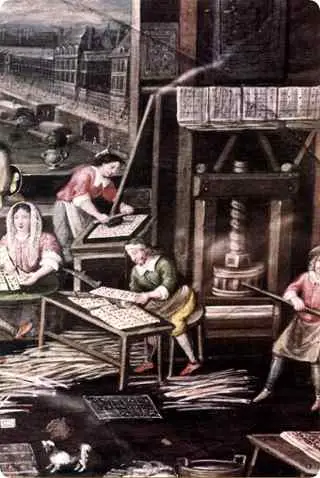
Making cards
PS Play cards for fun, never become like gamblers. Otherwise, a pleasant pastime can become a destructive force, from whose clutches it will be difficult to escape.
Information